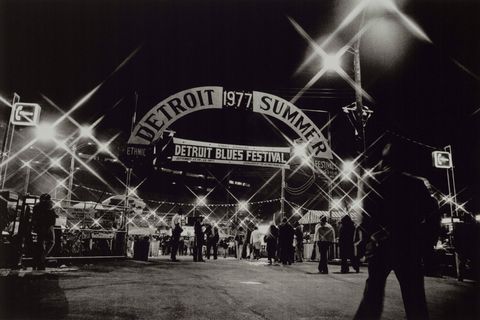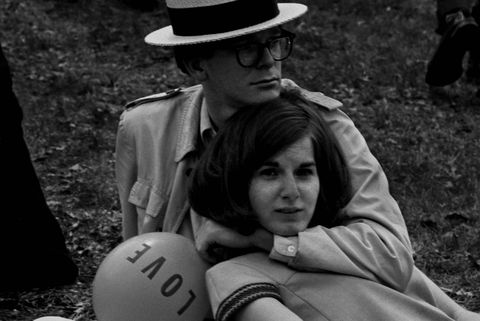Explore Detroit Photographer Russ Marshall's Shots from an Old Car Town
Tags: Detroit, Russ Marshall, Photographs
Russ Marshall was three years old when he moved from a coal town to a car town– from South Fork, Pennsylvania to Detroit, where his father took a job on a Chrysler assembly line building DeSotos. Marshall was in his teens when he got hold of a Scout 120 box camera and began capturing the people around him and the place he lived. He's 80 now, and 50 years of his most striking shots currently line the walls at the Detroit Institute of Arts. There was never a plan to turn his world into fine art.
"I just wanted to take interesting photos," he says.
Running until June 27, 2021, the showcase's full title is "Russ Marshall: Detroit Photographs, 1958–2008—An exhibition celebrating blue-collar workers throughout Southeast Michigan." That banner of a name still doesn’t capture the suffuse magic in the more than 90 black-and-white photographs that DIA photography curator Nancy Barr spent two years working with Marshall to select.
The photos express a city in full, the kind of consideration Detroit deserves, but rarely receives. Freed from the shadows and soul of the auto industry and Motown, Marshall reveals the benign scenes of any big city, full of regular folks attending to and enjoying regular activities on a regular day.
Growing up, he and his camera wandered out of the family living room and into the neighborhood, taking pictures of his friends, then into the Navy. From 1960-1964, Marshall served in the Navy as a photographer. Caribbean duty included stops in Jamaica and Cuba during the missile crisis.
Returning to Detroit after his discharge, he moved downtown near UAW headquarters in the early 1980s and picked up freelance photo work for the UAW magazine Solidarity. Gigs for unions like the Teamsters and the American Federation of Teachers followed. Marshall's a blue-collar son with ties to two faded industrial hubs, so one can read a hint of elegy in the "Workers" section of the exhibit. Here one finds photos from Ford's River Rouge Complex, the Acorn Iron Works in Detroit, a steel-town bar in Johnstown, Pennsylvania, and stacked meanings in the image "Ms. USA, Ford Motor Company, Batavia, Ohio."
"I knew and sensed over time that these jobs and these workers and these factories would someday be gone, replaced by something or nothing," Marshall said in a 2013 interview with American Elegy. "I had this opportunity to document and preserve the fact that these workers did exist at this time and in this place, like my coal mining, steel making relatives in our photo album."
The factory photos seem as though they'd be impossible to recreate today. Some workers pose, but they're doing so for themselves, not for a public relations department. Most workers don't wear protective gear. And the images are dark, Marshall combining his day job and matter-of-fact sensibility with his interest in film noir. If you see photos like these come out of a modern factory in the U.S., there have been breakdowns in the safety and the public relations departments.
Another series of prints documents Marshall's work in Europe. He told us Continental jaunts began when the head of the UAW asked him to come to a conference in Denmark. Over a number of trips from 1987 to 1990, Marshall photographed workers and daily scenes, like the two women waiting at the charcuterie station in Harrod's in London, and the disinterested guard slumped in a chair in Budapest next to a three-quarter statue of Lenin.
The "Everyday Detroit," "Public Life," and "Sounds of Detroit" photos are where Marshall injects high-contrast drama into the commonplace. LaMonte Hamilton playing sax at the Vanity Ballroom in 1982 could be auditioning for a spot at Rick’s Casablanca watering hole. Marshall shot "Woodward City Man" in 2000, but the only thing the image is missing is Orson Welles in The Third Man from 1949. "Ambassador Bridge and Zug Island" from 1968 and "Detroit Skyline with Water Tower #3" are models of German Expressionist cinematography, or screencaps from the movie Sin City, admitting that even the dark city must wake, even if to just the mere hint of the sun.
Between the industry and the darkness, Marshall captured Detroit icons like the Michigan Central Station when it was a train station, and Eastern Market. There are iconic moments such as the "Love Nuns" at the "maximum hippie" Love-In at Belle Isle, when something like 8000 longhairs occupied the island on April 30, 1967 "for several hours of singing, dancing, and probably a little bit of doobie-smoking as well." There are society moments like Henry Ford II dining with friends at the Renaissance Club and the Detroit Symphony Opera welcoming German conductor Günther Herbig, both from 1984. And then there’s just society, six-deep on the sidewalk watching the Palms Parade over Thanksgiving in 1964, united in curiosity like the seven men stopped to watch a construction site, and solo like the figure in "City Corner."
The DIA has served several online side dishes with the photographs, starting with an exhibition brochure and a large-print label booklet containing small images of the prints. Marshall also put together audio playlists of promiscuous variety to ease one into his noir ambience—Spotify here, YouTube here—with selections from Kerouac’s and Morgan Williams’ spoken word to Nina Simone, Thelonious Monk, Eminem, and the staggeringly enticing voice of Eva Cassidy.
Marshall offers six books on Blurb for those taken with his mood. You wouldn’t need a bottle of Michigan-sourced whiskey and an old pressing of Kind of Blue to savor the books, but those side orders would be excellent study aids.
Also currently at the DIA is its exhibit featuring 70 years of automotive design, Detroit Style. Share this article.
----------------------------------------------------------------------------------------------------------------------------
PHOTOGRAPHY FREEBIE:
How to make money with your Photography even if you're not a Pro.
Copy & paste this link into your browser, click ENTER, and enjoy:
https://mrdarrylt.blogspot.com/2020/01/how-to-make-500-month-from-your.html
or
https://www.photography-jobs.net/?hop=darryl54
-----------------------------------------------------------------------------------------------------------------------------
Visit me on Facebook and post your pictures.
https://www.facebook.com/Darryl-T-363867387724297/






No comments:
Post a Comment
Note: Only a member of this blog may post a comment.